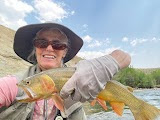By Bill Prater
Newbies! Don’t do this. Or if you must do this, wear a life jacket.
Today’s column is less a column and more of an appeal for advice from one of angling’s least trusted sources: the lunatic fringe of the float tube community.
This requires explanation. I am an aging example of a fishing fraternity that looks forward to late, late fall and early early spring - glorious, ice-age like times when the most cautious of trout throw caution to the wind. Even better, the more milquetoast, numerous members of the angling community turn to football and chasing moose and stuff. Trouble is, it’s also when Colorado/Wyoming’s usually balmy winds morph into damned hurricanes.
Over the years, I have acquired a level of success casting ultralights into the teeth of those gales. Don’t ask me how, exactly. But over years of cursing wind knots, I have stumbled upon combinations of eye and wrist coordination that allow me to fish amid the whitecaps.
Trouble is, I’m getting old! Wading into ice-cube filled water was questionable behavior even in my ‘60s. Now bones creak whenever autumn winds shove ice water down the front and back of my waders. Plus, with every passing season I am less steady on my feet and judgment.
So, with fall approaching, I’ve been thinking. One alternative is to simply wade out and cast from an upwind shoreline. Trouble is, that’s for wusses. And I suspect, but can’t verify, that biggest fish are more likely way downwind.
So here’s an alternative: Rather than wading in and hoping for the best, let’s flip, flip, flip, flip our float tubes out to the edge of a downwind honey hole. And then anchor! We can then cast with deadly precision to monsters lurking close to shore. Our lines are straight. We now detect every subtle bite. And we cast as far as Chad LaChance (who is no doubt hunting deer at this point, or watching TV.)
Trouble is - and here’s where I need your help - out in the whitecaps, how the hell do we safely anchor? I have an adorable, Navy-style miniature anchor that weighs maybe 2 pounds. Under milder conditions, it holds my Fat Cat over a sandy bottom barely long enough to reach for my coffee. Logically, if one were to swap that tiny anchor for a big old potato sack full of rocks, what happens next? Are you snugly anchored? Or was Linda right after all, and the wind is gonna flip myy belly boat over and leave me upside down flailing like an Olympics artistic swim team?
Let me know whether you’ve tried this, and whether it works better than I fear. The brutal, but tempting conditions of late fall are almost upon us. I can hardly wait.








